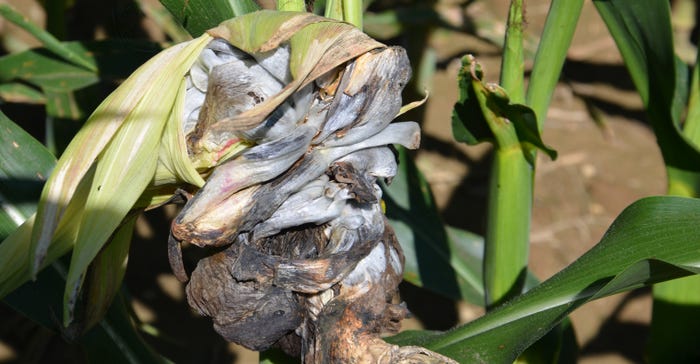
Anyone who farms with woods on one side of a field knows they will give up a few rows to a combination of shading from trees and damage from wildlife that live in the woods. That’s why some people opt to leave grass field borders at the edge of woods that border a field.
Dave Nanda wouldn’t have been surprised to find this “smut garden” in the outside half dozen or even dozen rows in from the woods on one side of the cornfield he was scouting. But he found this patch with smut on multiple plants within easy viewing distance some 60 to 70 rows into the field.
“That’s a bit unusual,” Nanda says. “But the smutty ears I observed were definitely the result of earlier feeding on the plants by deer.” Nanda is director of genetics for Seed Genetics Direct, based near Jeffersonville, Ohio.
Several growers have reported more damage from wildlife than usual already this year. Although the smut Nanda found was obviously caused by earlier feeding by deer, raccoons are also apparently more aggressive at attacking fields this year. Some people speculate this is because the early May freeze killed plants such as mulberry fruit, which raccoons and other wildlife usually feed upon during the summer.
Wildlife damage and smut
Where Nanda saw plants affected with smut, he also saw signs of earlier deer feeding. “Several plants had stubby leaves up and down the stalk,” he reports. “That’s an indication that a deer fed on the plant while it was small and leaves were still in the whorl.
“Other plants were missing their tops. The ear was appearing at the top of the plant. That happens when deer chomp off the top of a growing stalk.”
According to the 2020 edition of the Purdue University Corn & Soybean Field Guide, the fungus that causes smut often enters plants through a wound while the plant is small. Feeding by wildlife, including deer, can open up plants for invasion by spores that cause this fungus.
The galls are sometimes more silver in color than those seen here. But inside the galls are black spores, no matter the color on the outside. These spores survive in crop debris and are often still viable when plants are wounded, such as through feeding by wildlife, during the growing season.

CLASSIC CASE: Injury to this corn plant from feeding by deer opened this plant up to infection by the fungus that produces smut. This smut gall is filled with spores.

The Purdue guide notes that except on very susceptible hybrids, smut doesn’t cause economic damage by itself, and management for it isn’t warranted. However, Nanda notes that through a combination of stalks damaged by feeding or ears pulled off by raccoons and smut that develops instead of ears after wildlife damage, there could be a slight impact on yield, especially in fields near woods.
It’s something to consider when you’re investing in inputs and planting along a wooded area, Nanda says.
About the Author(s)
You May Also Like




